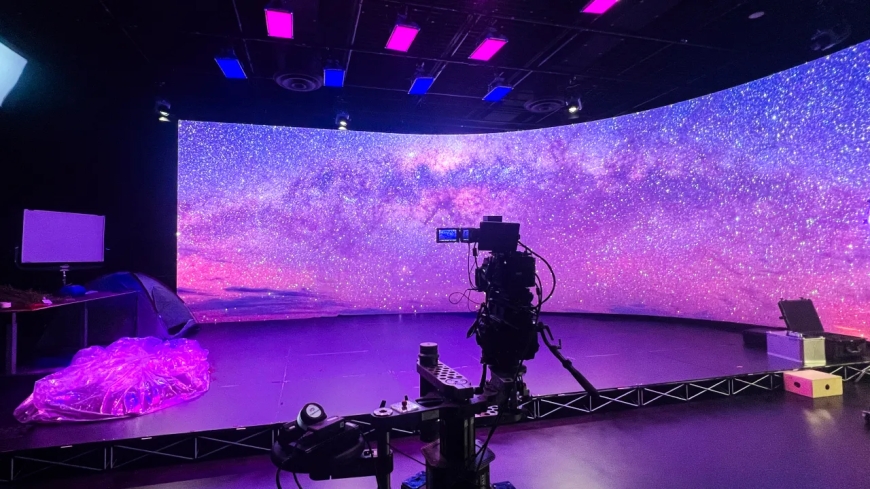The Rise of Virtual Production Studios: Revolutionizing Filmmaking
In the ever-evolving world of filmmaking, virtual production studios have emerged as a game-changer, blending cutting-edge technology with creative storytelling.

In the ever-evolving world of filmmaking, virtual production studios have emerged as a game-changer, blending cutting-edge technology with creative storytelling. These innovative spaces are transforming how films, TV shows, commercials, and even live events are produced, offering filmmakers unprecedented control over their environments. Whether you're searching for a virtual production studio near me or exploring the potential of virtual production studios globally, this guest post will dive into what makes these studios so revolutionary, their benefits, and how to find the right one for your project.
What is a Virtual Production Studio?
A virtual production studio is a filmmaking environment that integrates real-time digital technology, such as LED walls, motion capture, and game-engine software, to create immersive virtual sets. Unlike traditional green-screen setups, virtual production allows filmmakers to visualize and interact with digital environments in real time, streamlining the production process and enhancing creative possibilities.
At the heart of a virtual production studio is the LED wall, a massive, high-resolution screen that displays dynamic, photorealistic backgrounds rendered by game engines like Unreal Engine or Unity. These backgrounds react to camera movements and lighting changes, creating a seamless blend between physical and digital elements. Actors can perform within these environments, seeing the virtual world around them, which enhances their performances and reduces the need for extensive post-production.
Key Components of a Virtual Production Studio
- LED Walls: High-resolution screens that display real-time virtual environments.
- Motion Capture Systems: Track actors movements to integrate them with digital characters or elements.
- Real-Time Rendering Engines: Software like Unreal Engine or Unity that generate dynamic visuals instantly.
- Camera Tracking Technology: Ensures the virtual background aligns with the cameras perspective for realistic parallax effects.
- Lighting Integration: Matches physical lighting with virtual environments for seamless visuals.
Why Virtual Production Studios Are Transforming Filmmaking
The rise of virtual production studios has been fueled by their ability to address longstanding challenges in traditional filmmaking. Here are some key reasons why theyre reshaping the industry:
1. Real-Time Visualization
In traditional filmmaking, directors and cinematographers often rely on imagination or pre-visualization to envision how a scene will look after post-production. With virtual production, the entire team can see the final environment in real time on set. This reduces guesswork, allows for immediate creative decisions, and ensures the final product aligns with the directors vision.
2. Cost and Time Efficiency
While setting up a virtual production studio requires an initial investment, it can save significant time and money in the long run. By eliminating the need for location shoots or extensive post-production visual effects, studios can reduce travel costs, set construction expenses, and editing time. For example, a scene set in a futuristic city or a distant planet can be filmed in a studio without ever leaving the lot.
3. Enhanced Creative Control
Virtual production studios give filmmakers unparalleled control over every aspect of the environment. Need to change the time of day, adjust weather conditions, or tweak the background? With real-time rendering, these changes can be made on the fly, allowing for rapid experimentation and iteration.
4. Immersive Actor Performances
Actors no longer have to perform against a green screen, imagining their surroundings. In a virtual production studio, they can see and interact with the environment, leading to more authentic performances. This immersive approach also helps directors and actors collaborate more effectively on set.
5. Sustainability
Traditional filmmaking often involves extensive travel and set construction, which can have a significant environmental impact. Virtual production studios minimize the need for physical sets and location shoots, reducing the carbon footprint of productions and aligning with the industrys growing focus on sustainability.
Applications of Virtual Production Studios
The versatility of virtual production studios makes them suitable for a wide range of projects. Here are some of the most common applications:
1. Film and Television
Blockbusters like The Mandalorian and The Batman have popularized virtual production, using LED walls to create expansive worlds without leaving the studio. From sci-fi epics to historical dramas, virtual production studios enable filmmakers to craft any setting imaginable.
2. Commercials and Advertising
Brands are increasingly turning to virtual production for high-impact commercials. The ability to create polished, dynamic visuals quickly makes it ideal for advertising campaigns with tight timelines and budgets.
3. Live Events and Broadcasts
Virtual production is also revolutionizing live events, such as award shows, concerts, and sports broadcasts. LED walls can create immersive backdrops that enhance the audience experience, while real-time rendering allows for dynamic visuals that respond to the event.
4. Gaming and Interactive Media
The gaming industry has long used game engines like Unreal Engine, and virtual production studios bridge the gap between gaming and filmmaking. This synergy allows for the creation of interactive experiences, such as virtual reality (VR) films or immersive gaming environments.
5. Corporate and Educational Content
Businesses and educational institutions are using virtual production studios to create engaging training videos, product demonstrations, and virtual tours. These studios offer a cost-effective way to produce high-quality content without the logistical challenges of traditional shoots.
Finding a Virtual Production Studio Near Me
If youre searching for a virtual production studio near me, there are several factors to consider to ensure you find the right facility for your project. Heres a step-by-step guide to help you locate and choose the perfect studio:
1. Identify Your Project Needs
Before searching, define the scope of your project. Consider:
- The type of production (film, commercial, live event, etc.).
- The size of the LED wall or stage required.
- The level of technical expertise needed (e.g., motion capture, real-time rendering).
- Your budget and timeline.
2. Research Local Studios
Many major cities now have virtual production studios, especially in filmmaking hubs like Los Angeles, New York, London, and Atlanta. Use online directories, industry networks, or search engines to find studios in your area. Keywords like virtual production studio near me can help narrow down options.
3. Evaluate Studio Capabilities
Not all virtual production studios are created equal. When researching, check for:
- Equipment Quality: Ensure the studio has high-resolution LED walls, advanced camera tracking, and reliable rendering software.
- Technical Support: Look for studios with experienced technicians who can assist with setup and operation.
- Stage Size: Confirm the studios stage is large enough for your production needs.
- Portfolio: Review the studios past projects to gauge their expertise and versatility.
4. Consider Accessibility and Amenities
Choose a studio thats conveniently located and offers additional amenities, such as soundstages, editing suites, or on-site equipment rentals. Accessibility to major transportation hubs can also be a factor if youre bringing in crew or talent from out of town.
5. Request Quotes and Availability
Contact studios to discuss pricing, availability, and any additional services they offer, such as pre-production planning or post-production support. Compare multiple options to find the best fit for your budget and schedule.
6. Visit the Studio
If possible, visit the studio in person to assess the facilities and meet the team. This can help you gauge their professionalism and ensure the space meets your creative and technical requirements.
The Future of Virtual Production Studios
As technology continues to advance, virtual production studios are poised to become even more integral to the entertainment industry. Here are some trends to watch:
1. Improved LED Technology
Next-generation LED walls are becoming more affordable and offering higher resolutions, making virtual production accessible to smaller studios and independent filmmakers.
2. Integration with AI and Machine Learning
AI is already being used to enhance real-time rendering, automate lighting adjustments, and streamline post-production workflows. As AI technology evolves, it will further simplify and enhance virtual production processes.
3. Expanded Accessibility
As the cost of virtual production technology decreases, more studios worldwide are adopting these tools, making it easier to find a virtual production studio near me no matter where youre located.
4. Hybrid Workflows
The lines between virtual production, traditional filmmaking, and other media forms are blurring. Hybrid workflows that combine virtual production with practical effects and traditional sets will become more common, offering filmmakers even more creative flexibility.
5. Education and Training
As demand for virtual production grows, universities and training programs are offering courses to teach the next generation of filmmakers how to use these tools. This will create a larger pool of skilled professionals, further driving adoption.
Challenges of Virtual Production Studios
While virtual production studios offer numerous benefits, they also come with challenges:
- High Initial Costs: Setting up a virtual production studio requires significant investment in equipment and software.
- Learning Curve: Filmmakers and crew may need training to master the technology.
- Technical Limitations: While rare, issues like rendering lag or equipment malfunctions can disrupt shoots.
- Creative Constraints: Overreliance on virtual environments could limit the use of practical effects or real-world locations.
Despite these challenges, the advantages of virtual production far outweigh the drawbacks for most projects, and ongoing advancements are addressing these issues.
Conclusion
Virtual production studios are revolutionizing the way stories are told, offering filmmakers a powerful toolkit to bring their visions to life. From blockbuster films to small-scale commercials, these studios provide unmatched creative control, efficiency, and sustainability. Whether youre a seasoned filmmaker or a newcomer searching for a virtual production studio near me, the rise of this technology opens up exciting possibilities for storytelling.
By understanding the capabilities of virtual production studios and carefully selecting the right facility for your project, you can harness this innovative technology to create stunning, immersive content. As the industry continues to evolve, virtual production is set to redefine filmmaking, making now the perfect time to explore its potential.










































